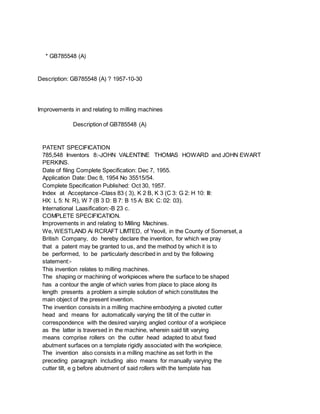This document summarizes a patent for improvements to magnetic amplifiers. It describes a magnetic amplifier with a reversible cycle of operation corresponding to half cycles of line current. It alternately saturates pairs of cores in opposite directions using line current flux, while also exposing at least one core to a signal current flux to separate the core saturations during some cycles. It controls output current delivery within these cycles based on the core saturation without transferring memory between cycles. The document also discusses characteristics of magnetic amplifiers like hysteresis loops and core saturation levels.




![* Sitemap
* Accessibility
* Legal notice
* Terms of use
* Last updated: 08.04.2015
* Worldwide Database
* 5.8.23.4; 93p
* GB785549 (A)
Description: GB785549 (A) ? 1957-10-30
Improvements in or relating to magnetic amplifiers
Description of GB785549 (A)
A high quality text as facsimile in your desired language may be available
amongst the following family members:
BE535294 (A) CH359753 (A) DE1140976 (B) FR1120616 (A)
US2777073 (A) US2827603 (A) US2827608 (A)
BE535294 (A) CH359753 (A) DE1140976 (B) FR1120616 (A)
US2777073 (A) US2827603 (A) US2827608 (A) less
Translate this text into Tooltip
[91][(1)__Select language]
Translate this text into
The EPO does not accept any responsibility for the accuracy of data
and information originating from other authorities than the EPO; in
particular, the EPO does not guarantee that they are complete,
up-to-date or fit for specific purposes.
PATENT SPECIFICATION
785,549 Date of Application and filing Complete Specification Jan 13,
1955.
No 1081/55.
Application made in United States of America on Feb 26, 1954.
Application made in United States of America on May 24, 1954.](https://image.slidesharecdn.com/u25maliestqy5qeclbmt-signature-f4a774dd4f98ae6ae9e38dcde0935d18b3110955c07bb111141714940598977e-poli-160125212923/85/5141-5145-output-5-320.jpg)






































![A high quality text as facsimile in your desired language may be available
amongst the following family members:
DE1017626 (B) FR1118260 (A) US2747716 (A)
DE1017626 (B) FR1118260 (A) US2747716 (A) less
Translate this text into Tooltip
[83][(1)__Select language]
Translate this text into
The EPO does not accept any responsibility for the accuracy of data
and information originating from other authorities than the EPO; in
particular, the EPO does not guarantee that they are complete,
up-to-date or fit for specific purposes.
PATENT SPECIFICATION
7 Date of Application and filing Complete Specification: Jan 27, 1955.
9 No 2530/55.
Application made in Germany on Jan 27, 1954.
Complete Specification Published: Oct 30, 1957.
Index at acceptance:-Class 100 ( 4), C 20 (B 2 A: GIA).
Index at acceptance:ication:-B 41 j.
COMPLETE SPECIFICATION
A Typewriter including means' for Double Letter Space Typing We,
OLYMPIA WERKE AG, of Wilhelmshaven, Germany, a German Body Corporate,
do hereby declare the invention for which we pray that a patent may be
granted to us, and the method by which it is to be performed, to be
particularly described in and, by the following statement: -
The invention relates to a typewriter comprising an actuating
mechanism for obtaining double letter-spacing.
A known mechanism of this kind effects a double step of the escapement
for the double letter-spacing by varying the stroke of the loose dog
which' is formed, like a slide The variation of the stroke is effected
by means of a special control device actuated by the double
letter-spacing key.
It is the object of the invention to devise an arrangement for the
double letter-spacing key which is particularly advantageous and
reliable in service, and which, if the key is depressed, actuates the
control device for effecting the double letter-spacing, locks this
device in its position, and' again releases this device for normal
typing by a repeated downward's movement of the key so that, in
contrast to systems known hitherto, it is not necessary to impart to
the double letter-spacing key a movement in an, additional direction](https://image.slidesharecdn.com/u25maliestqy5qeclbmt-signature-f4a774dd4f98ae6ae9e38dcde0935d18b3110955c07bb111141714940598977e-poli-160125212923/85/5141-5145-output-44-320.jpg)










